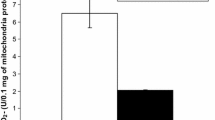Abstract
Previous research has described how high cellular metabolism creates an acidic environment in inflammatory cells during respiratory burst. The aim of our work was to describe the acid-base dependence of exudate in superoxide O2 •− and nitric oxide (NO·) generation by inflammatory cells from a carrageenan-granuloma. Although the carrageenan solution was alkaline (pH 7.74 when equilibrated with air) the exudate showed an acidification that stabilised at around 7 units of pH. A notable hypercapnia, but not hypoxia, was found in the exudate at up to 24 h. The effect of extracellular acidosis on O2 •− and NO· production by inflammatory cells was also studied. The maximum O2 •− production and the lowest levels of NO· were found at pH7, which was closer to the pH of the granuloma-pouch. These results suggest that experiments with inflammatory cellsex vivo should be carried out at an identical pH to that foundin vivo in order to reproduce the physiological mechanisms of free radical generation during inflammatory processes.
Resumen
Se ha descrito que el elevado metabolismo celular de las células inflamatorias genera un entorno ácido. El propósito de este trabajo es estudiar si la generación de superóxido y de óxido nítrico por las células inflamatorias depende del grado de acidez del exudado. Para ello, se ha utilizado un modelo de granuloma por inyección de una solución de carragenina. Aunque el pH original de esta solución era alcalino (pH=7,74 en equilibrio con aire), el pH del exudado evoluciona hacia valores más ácidos, estabilizándose en torno a 7. A las 24 horas, el análisis del exudado revela una manifiesta hipercapnia pero ausencia de hipoxia. Se estudia la influencia de la acidosis extracelular sobre la producción de superóxido y de óxido nítrico por las células inflamatorias. Los máximos niveles de producción de superóxido y mínimos de óxido nítrico se encuentran a pH=7, valor próximo al del pH del exudado inflamatorio. Estos resultados sugieren que, para reproducir los mecanismos fisiológicos responsables de la generación de radicales libres durante los procesos inflamatorios, los experimentos con células inflamatoriasex vivo deben ser realizados a un pH idéntico al encontradoin vivo.
Similar content being viewed by others
References
Ródenas, J., Mitjavila, M. T., and Carbonell, T. (1995):Free Rad. Biol. Med.,18, 869–875.
Huie, R. E. and Padmaja, S. (1993):Free Rad. Res. Comms.,18, 195–199.
McCall, T. B., Boughton-Smith, N. K., Palmer, R. M. J., Whittle, B. J. R. and Moncada, S. (1989):Biochem J.,261, 293–296.
Stevens, C. R., Williams, R. B., Farrell, A. J. and Blake D. R. (1991):Ann. Rheum. Dis.,50, 124–132.
Alfaro, V., Ródenas, J., Pesquero, J., Palacios, L., Mitjavila, M. T. and Carbonell, T. (1996):Inflamm. Res.,45, 405–411.
De Brito, F. B. (1989): In “Modern Methods in Pharmacology” (Chang J. Y. and Lewis, A. J., eds.), Adan R. Liss, New York, pp. 173–194.
Punnia-Moorthy, A. (1987):J. Oral Path.,16, 36–44.
Fleming, I., Hecker, M. and Busse, R. (1994):Circ. Res.,74, 1220–1226.
Laman, D., Theodore, J. and Robin, D. E. (1981):Exp. Lung Res.,2, 141–153.
Fukuhara, M., and Tsurufuji, S. (1969):Biochem. Pharmacol.,18, 475–484.
Johnston, R. B., Godzik, C. A., and Cohn, Z. A. (1978):J. Exp. Med.,148, 115–119.
Ródenas, J., Carbonell, T. and Mitjavila, M. T. (1996):Arch. Biochem. Biophys.,327, 292–294.
Hambleton, P. and Miller, P. (1989):Brit. J. Exp. Pathol.,70, 425–433.
Strauss, B. S. and Stetson, C. A., Jr. (1960):J. Exp. Med.,112, 635–638.
Suzuki, Y. and Lehrer, R. J. (1980):J. Clin. Invest.,66, 1409–1418.
Yaqoob, M., Edelstein, C. L., Wieder, E. D., Alkhunaizi, A. M., Gengaro, P. E., Nemenoff, R. A. and Schrier, R. W. (1996):Kidney Int.,49, 1314–1319.
McCall, T. B., Palmer, R. M. J. and Moncada, S. (1991):Eur. J. Immunol.,21, 2523–2527.
Biemond, P., Swaak, A. J. G., Penders, J. M. A., Beindorf, C. M. and Koster, J. F. (1986):Ann. Rheum. Dis.,45, 249–255.
Hogg, N., Darley-Usmar, V. M., Wilson, M. T. and Moncada, S. (1992):Biochem. J.,281, 419–424.
Zhu, L., Gunn, C. and Beckman, J. S. (1992):Arch. Biochem. Biophys.,298, 452–457.
Fernandes, A. C., Filipe, P. M. and Manso, C. F. (1995):Redox Report,1, 139–144.
Author information
Authors and Affiliations
Rights and permissions
About this article
Cite this article
Carbonell, T., Ródenas, J., Alfaro, V. et al. Extracellular pH affects inflammatory cell production of superoxide and nitric oxide. J. Physiol. Biochem. 58, 115–120 (2002). https://doi.org/10.1007/BF03179847
Received:
Issue Date:
DOI: https://doi.org/10.1007/BF03179847




